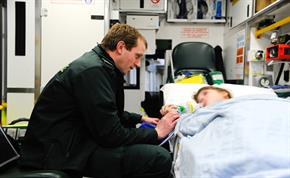
By Emma Hicks, Paramedic at Waveney
Being able to communicate with patients as individuals is an imperative basic skill. Despite this, 70% of complaints in the NHS are related to poor communication. History taking is the first stage of the process, and if done well, it alone can help give the diagnosis before the clinician has even physically examined the patient. It identifies what has happened, the patient’s personality (helping you build a relationship with them and learn how best to communicate with them), how the illness has affected them and their family, specific anxieties relating to the illness and the patient’s physical and social environment.
In a pre-hospital setting though, clinicians don’t always have the luxury of time when gathering information and taking a history, particularly when the patient is critically ill. We are taught that mechanism of injury is of particular relevance in trauma, whilst in medical cases it is events leading to presentation that is the key. In such situations we learn to take history efficiently. In a high percentage of our daily workload we can work to a pace that is of comfort to the patient, building on a set routine approach that leads to thoroughness and efficiency.
We can all do it, but sometimes it’s useful to go ‘back to basics’ and remind ourselves of some basic dos and don’ts: Let the patient explain what has happened. Try and conduct a conversation rather than an ‘interrogation’, following the patient’s train of thought. Also try to avoid leading questions – remember the aim is to take a history and to understand the patient’s symptoms from their own point of view. It’s also important not to blemish the patient’s history with your own expectations. Be sensitive to the patient’s mood and non-verbal responses, as this may be indicative of how your patient relationship builds and in turn impacts the quality of your history taking. Be understanding, receptive and matter-of-fact without excessive sympathy or judgement. Use an analytical approach for each sign or symptom - one needs to think of a differential diagnosis and of other relevant information. Then by taking a good history, examination or investigation, each possible diagnosis will be supported or refuted.
A family history not only gives clues to possible predisposition to illness but also an insight into if, and why, a patient might have particular reason to be anxious about a certain disease. It is of great importance that you understand the patient’s main ideas, concerns and expectations – their concerns may not be your concerns. Active listening leads to fewer patient complaints.
In simple terms identify your patient’s: feelings related to the illness, ideas on what is happening to them, functioning in terms of the impact on their daily life, and expectations of the illness and you (FIFE). Address these concerns. Summarise what your patient has told you and reflect it back to them, giving them the opportunity to correct anything you have misunderstood and add anything that may have been forgotten.
Reassurance has a great impact on the patient, as does the clinicians apparent casual dismissal of a problem. Simple mannerisms of how a clinician learns to conduct his or herself can affect the patient’s experience at completely different ends of the spectrum.
As we know, a clinical handover is the transfer of responsibility and accountability to another professional; it is at handover that the need for clear, concise communication is needed most. It’s at this stage that the opportunity for highlighting concerns can be missed. A communication tool used in many hospital handovers, known as SBAR, can help:
Try to make the handover concise and to the point, but long enough to command the staff member’s attention and ensure all key points are communicated clearly. Good communication focuses on your patients as individuals, giving them a better patient experience, and importantly, facilitates good care.
Published 6th July 2014